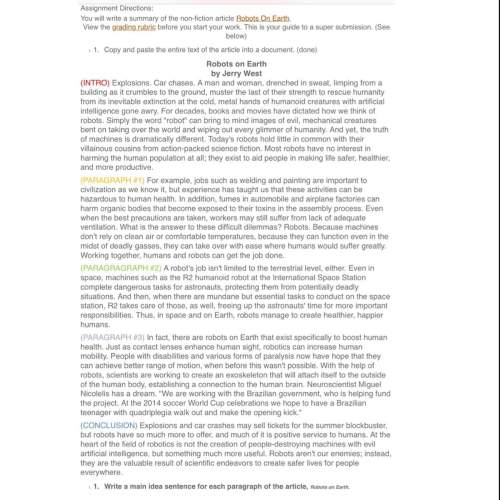
English, 05.11.2020 23:10 xocamiryn6584
In this essay, you are asked to interpret the meaning of a quotation and analyze a work of literature as it pertains to the quote. The steps to do this are explained in the video instructions throughout each step of the writing process. You may choose to read a new novel, or use one you have previously read. You may also choose to analyze a novel excerpt you read earlier in this course, such as Monster.
Writing Prompt:
“Write an essay that analyzes one work of literature that you have read from the perspective of a quotation. In your essay, interpret the quotation and explain whether it applies to a work of literature you have read. Support your opinion using literary terms and elements as well as details from the text.
Lens Quotation: "Character is what you are in the dark." -Dwight Lyman Moody”
You will accomplish this by using the following techniques:
Third person point of view (onlooker—he, she, they)
Identify literary devices used in the novel
Formal and appropriate language
Vivid descriptions
Key points about this essay:
Pay close attention to each video set of Instructions; the writing prompt is outlined in detail and broken down for you.
Warm-Up
In Frame 1, the instructor explains how to read and interpret a quotation so you may apply it to a work of literature you have read. In Frame 2, section 1:06-2:23, she explains how to interpret an additional quote.
Instruction Video 1—Prewriting
In this video, the instructor explains how to choose a novel in order to complete this assignment. You may use a novel you have read prior to this, as long as you can find examples from the book to support your claims in the essay. You may also use one of the novel excerpts you covered earlier in this course, such as Monster.
Instruction Video 2—Prewriting
In the “Breaking Down the Prompt into Steps” section (Frame 2, 1:51-2:35), the instructor explains how to break the prompt into steps for your analysis:
Interpret the quotation.
Explain whether it applies to a text you have read.
Support your opinion with details.
In Frame 2, section 2:36-3:3, (“Interpreting a Quotation”), the instructor explains the process of interpreting a quotation by doing the following:
Put the quotation into your own words.
Interpret the meaning
In Frame 4, section 0:00-1:09 (“Next Steps”), she outlines the steps to generally organize your thoughts for this assignment:
Interpret the quotation.
Explain the meaning in your own words.
Explain whether it applies to a text you have read.
Choose a text.
Take a stand (agree or disagree).
Support your opinion.
Use examples from a piece of literature you have read to support your opinion.
Later in Frame 4, section 1:09-3:41 (“Formulating an Opinion”), she models how to analyze literature based on an interpretation of your prompt quote. Remember: You must choose to agree or disagree, but you can’t do both.
Make sure you organize your thoughts during the Prewriting process. In Frame 6, the instructor models how to use a Web Organizer. I recommend using this to organize your thoughts.
Drafting
The essay must consist of 5 paragraphs—an introduction, three (3) body paragraphs, and a conclusion. “Building an Effective Draft” on Frame 2, section 0:00-0:41, explains in detail how these paragraphs should be structured:
Introduction: Quotation + interpretation + opinion + thesis. The Thesis will be the last sentence in the Introductory paragraph.
Body Paragraph 1:
Reason 1 (Topic Sentence)
Evidence (several sentences to support Reason 1). Include examples from the novel.
Body Paragraph 2:
Reason 2 (Topic Sentence)
Evidence (several sentences to support Reason 2). Include examples from the novel.
Body Paragraph 3:
Reason 3 (Topic Sentence)
Evidence (several sentences to support Reason 3). Include examples from the novel.
Conclusion

Answers: 2
Another question on English

English, 21.06.2019 21:40
While studying, lana reached her goal of reading half a chapter without interruptions. what should she do next?
Answers: 2

English, 22.06.2019 03:40
Select all that apply. a character sketch may deal with only one character trait must be favorable must begin with a formal outline might include details of physical appearance or conduct
Answers: 1


English, 22.06.2019 08:00
Why didn't van gogh knock on breton's door? it seemed imposing and a bit scary. it looked alarmingly middle-class. he couldn't find the door. he saw a book that he liked instead.
Answers: 1
You know the right answer?
In this essay, you are asked to interpret the meaning of a quotation and analyze a work of literatur...
Questions

Arts, 30.01.2021 02:40

Engineering, 30.01.2021 02:40

Mathematics, 30.01.2021 02:40


Mathematics, 30.01.2021 02:40

Mathematics, 30.01.2021 02:40


World Languages, 30.01.2021 02:40

Mathematics, 30.01.2021 02:40

Mathematics, 30.01.2021 02:40

Physics, 30.01.2021 02:40

Mathematics, 30.01.2021 02:40

Biology, 30.01.2021 02:40

Mathematics, 30.01.2021 02:40


Law, 30.01.2021 02:40

Mathematics, 30.01.2021 02:40

Mathematics, 30.01.2021 02:40





